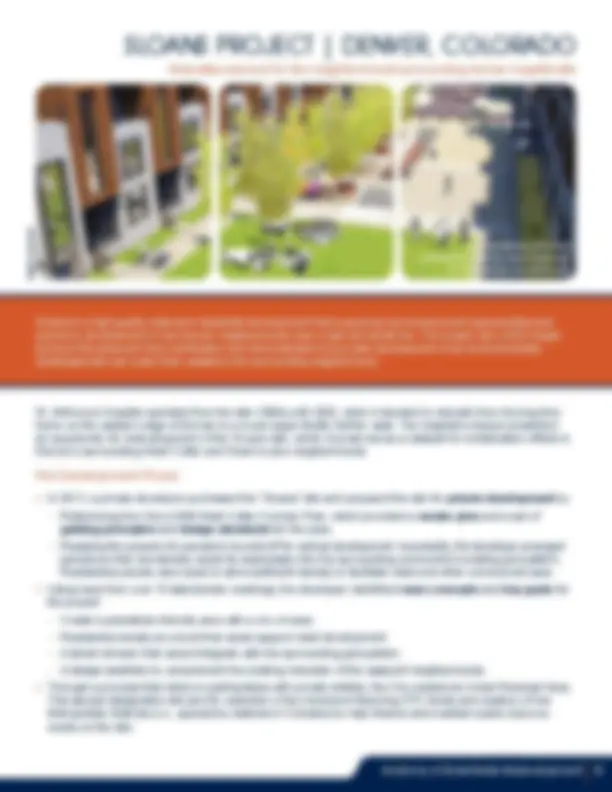










Study with the several resources on Docsity

Earn points by helping other students or get them with a premium plan


Prepare for your exams
Study with the several resources on Docsity

Earn points to download
Earn points by helping other students or get them with a premium plan
Community
Ask the community for help and clear up your study doubts
Discover the best universities in your country according to Docsity users
Free resources
Download our free guides on studying techniques, anxiety management strategies, and thesis advice from Docsity tutors
The benefits of brownfields redevelopment, including reducing blight and preserving greenspace. It outlines three scenarios for brownfields redevelopment: private-led, public-led, and public-private partnerships. The document also discusses the financing options for brownfield redevelopment, including private equity, construction financing, and permanent financing.
What you will learn
Typology: Summaries
1 / 14

This page cannot be seen from the preview
Don't miss anything!









Brownfields are properties that are or may be contaminated with hazardous substances, pollutants, petroleum, or other contaminants. These contaminants pose a barrier to redevelopment. Brownfields often are in struggling neighborhoods and areas with blight, deteriorated infrastructure, or other challenges. These properties often are eyesores as well as potential health and safety concerns for the community. Cleaning up and redeveloping a brownfield property enables infill development, increases the tax base, spurs job creation and often kick-starts revitalization activities within a neighborhood. Depending on the location and characteristics of the property and market factors, a brownfield site often can be redeveloped for uses ranging from housing, retail, industrial, or mixed-use to public and non-profit uses such as parks, recreational areas and municipal facilities. Brownfields redevelopment offers benefits over greenfield development, such as: reducing blight and improving the local environment by cleaning up contamination, moving abandoned or underused sites into beneficial reuses, and reducing sprawl and preserving greenspace. Brownfields can be redeveloped by private developers, local governments or through public-private partnerships.
Opportunity and risk are inherent in every real estate transaction. Developers must invest their resources to evaluate whether the development opportunity outweighs the risk. In a brownfields redevelopment, a developer must consider the additional risk that the property is or may be contaminated. This means that a brownfields developer must invest their resources to evaluate whether the real estate opportunity outweighs both brownfield-specific and real estate risks. Opportunities often present when redeveloping brownfields include: Prime Locations – An opportunity to acquire and develop a property in a highly desirable location where there may be few or no other properties available. Reduced Purchase Price – Due to potential contamination, brownfield properties often can be acquired at a reduced cost—which could potentially increase profit.
Office of Brownfields and Land Revitalization (5105T) EPA 560-F-19-012 | June 2019
Existing Infrastructure – An opportunity to save money, because brownfield properties often have existing infrastructure and are in locations accessible to roads, rail lines, ports and public transportation. Risks or challenges unique to brownfields real estate transactions include: Liability – Concerns over who is responsible for the environmental contamination often plague brownfield properties. Potential developers must evaluate: Who will pay for the environmental cleanup-- a responsible party or the developer? Cleanup and Timing – Environmental assessments and cleanup can complicate brownfield redevelopment projects because exact timelines and costs are often difficult to determine. Developers must ask themselves if the environmental cleanup and the subsequent type of development make sense from an economic perspective. Financing – Typical financing may not be available to brownfields real estate transactions because lenders may not be comfortable with the unknowns associated with contaminated properties. Weak Demand – Brownfields are not always located in thriving areas where real estate markets are strong. As a result, alternative analyses may be necessary to kick-start the redevelopment process. (See box on page 7, Brownfields in Weak Real Estate Market Areas .)
Communities often experience several benefits from brownfield site redevelopment, regardless of how the site is reused. Benefits include: Environmental – By addressing the environmental conditions of a brownfield, the project can reduce or eliminate exposure to environmental contamination and enhance the health and safety of the community. Sustainability – Brownfields real estate transactions provide an opportunity to integrate environmental cleanup with sustainable reuse of a property. Coupling these two activities can ensure site cleanup and address environmental risk. Community Involvement – When a brownfield site is in a weak market, local stakeholders may be more likely to become involved. As a result, the community often is much more invested in the project and its results. Goodwill – Redeveloping a brownfield site provides an opportunity to create new or improve community amenities nearby.
The three stages of the brownfield redevelopment process are pre-development , development , and management. Each stage requires specific actions, funding and/or financing. Integrating cleanup and redevelopment activities as appropriate at each stage is the key to cost-effective, sustainable brownfields redevelopment.
Generally, the activities outlined here for each stage are undertaken by developers. Communities and municipalities undertaking brownfield redevelopment projects or forming public-private partnerships can use this information to better understand how a developer approaches a brownfield redevelopment opportunity. Pre-Development Development Management Conduct Due Diligence. Conduct Analyses. Determine any Fatal Flaws. Develop the ProForma and Agreement for Purchase of Property. Use the Proforma to Refine the Site Design. Prepare a Redevelopment Plan. Identify Sources of Funding. Acquire Environmental Insurance. Obtain Permits and Necessary Approvals. Conduct Environmental Cleanup and Site Preparation Activities. Conduct Marketing and Pre-leasing Activities. Complete Construction and Open the Project. Hold the Property. Developer/owner assumes O&M responsibilities. OR Sell the Property. Buyer assumes O&M responsibilities.
Pre-development activities lay the foundation for a successful brownfield redevelopment project. The developer (or local government, for a publicly funded project) conducts several analyses, assesses the feasibility of a project and decides whether the project should move forward. This is the riskiest phase for potential private developers because they are investing money upfront without a guarantee of any return. During this phase, the developer usually does the following: Conducts Due Diligence. Due diligence involves a variety of activities in advance of purchasing a proper- ty and activities specific to the environmental compo- nents of the redevelopment. These activities typically include: Conducting property and environmental assess- ments. Researching land and building titles for the property. Continuing communications with key stakeholders about the planned redevelopment. Conducts Various Analyses. These may include: An analysis to evaluate the physical and regulatory development potential of the property. If purchasing the brownfield property, the devel- oper must conduct all appropriate inquiry (AAI) before acquiring the property and comply with continuing obligations after acquiring the property. AAI is the process of evaluating a property’s environmental conditions and assessing potential liability for any contamination. Performing AAI and complying with continu- ing obligations provides the developer with a defense to liability under the Comprehensive Environmental Response, Compensation, and Liability Act (CERCLA).
An initial feasibility analysis that usually consists of quick, back-of-the-envelope calculations. A feasibility analysis to evaluate and understand different types of project risk, including financial and environmental risk. A market assessment to identify reuse options. (See box on page 6, Brownfields in Weak Real Estate Market Areas .) Determines Any Fatal Flaws. Once the due diligence and various analyses are complete, the developer will determine if there are any obvious fatal flaws. Develops the Proforma and an Agreement for Purchase of Property. If proceeding with the project, the developer will move forward with an in-depth finan- cial proforma and negotiate their contract terms to purchase the site. These negotiations are a method of risk management and address key issues, such as liability, financial risk, environmental covenants, institutional controls, and regulatory assurances. These negotiations lead to an agreement to purchase the property from the seller (i.e., a letter of intent or Purchase and Sale Agreement). Uses the Proforma to Refine Site Design and Maximize Profit. The proforma can be used to guide the site design process by calculating estimated costs and profit derived from different buildable square footage and site constraint inputs. A potential developer will likely explore several redevelopment concepts during this phase to ensure that the project is feasible finan- cially and from an environmental standpoint. Prepares a Redevelopment Plan. If a decision is made to go forward, the developer will begin redevelopment planning for the site, based on the information gathered and the market assessment. A sustainable redevelopment plan will integrate site assets and limitations, incorporate neighborhood features, address community concerns, and satisfy market demand. A redevelopment plan generally includes: A Community Engagement Plan that is implement- ed early in the process to build public and regulatory support for the project. Creating community buy-in for the intended reuse can facilitate entitlements, reduce delays, and minimize risks. A Site Reuse Vision , which is a visual representation of the redevelopment plan that is used to communi- cate with stakeholders, regulatory officials, economic development leaders, and the real estate market. A Redevelopment Implementation Strategy , which is a step-by-step strategy for obtaining regulatory approvals, community support, and implementing the redevelopment plan. A Resource Roadmap , which identifies public incentives that may be available and needed to help finance the development, and potential funding sources for making infrastructure improvements to attract tenants and end users. This may be particularly important for developments located within a weak market. Back of the envelope calculations are a quick and basic way to evaluate a transaction, using only high-level costs and income. This does not substitute for a pro forma. A pro forma is a spreadsheet that provides a clear, numeric representation of future costs and income, and calculates the projected return on the investment. A pro forma usually contains: Operating or cash flow statement. Income and expense analysis. Annual property operating data. Loan information, including the repayment schedule. Early determination of the property’s reuse will ensure that cleanup efforts complement the reuse goal and that stakeholders are invested in the redevelopment process. In a private-led redevelopment scenario, the developer typically generates and refines the redevelopment idea. In the public-led or public-private partnership redevelopment scenario, community input drives the redevelopment idea.
What is a weak real estate market or a weak economy? A weak market is a market in which sellers far outnumber buyers and prices are in a general state of decline, or where there is little demand for a property. A market can be weak for one or more sectors (commercial, retail, housing, industrial, etc.), or for all sectors. Are brownfield sites found in weak market areas? Brownfield sites often—but by no means always—are found in “weak market” areas. This adds to the complexity of the redevelopment. For some brownfield real estate transactions, the market may be weak for any type of development, rather than only for specific sectors (e.g., commercial, retail, warehouse, residential). In weak markets, the community’s desire for redevelopment, or a specific type of development, may precede an identified developer. As a result, the reuse vision may come before a developer is identified and the community may need to conduct an alternative analysis to focus on how to generate demand. When the entire market is weak, there is no “tried and true” method to kick-start demand for a brownfield site. An alternative analysis is needed to find the unique aspects of each city, neighborhood, or community that can generate demand for the site. This alternative analysis will be conducted by a private developer that is considering undertaking a redevelopment, or by a community undertaking its own publicly funded redevelopment or seeking to form a public-private partnership. “Asset mapping” is a commonly-used term to describe this type of alternative analysis. The analysis generally includes the following steps: Identify potential users, partners, and institutions. Focus on key strengths to develop demand. Target existing assets (e.g., waterfront, transportation infrastructure, etc.) Identify available public incentives. Conducts Marketing and Pre-leasing Activities to Attract Potential Buyers or Tenants. Leasing begins when the construction schedule is determined. After construction is complete, the property may or may not be sold. A commercial property may be sold or leased for long-term management. However, in most cases the property is leased first. Completes Construction and Opens the Project. A brownfields project may be considered successfully redeveloped after construction is complete, ownership and leasing transactions are finalized, and the property is occupied and operating as its planned reuse.
During the management (or operational) phase, the developer decides whether to: hold the property for the long-term and assume responsibility for operation and maintenance (O&M), OR sell the property to another entity that will take over long-term responsibility for O&M. If the developer chooses to sell the property, the devel- oper must ensure that ongoing maintenance required under the remedial action plans and any institutional controls are transferred to the new buyer.
During the management phase , three types of funding generally are available to the developer: Operating income (e.g., rents). Tax abatements. Workforce or economic development incentives. Many brownfield properties incorporate engineer- ing and/or institutional controls in their remedial plans that restrict property access or use. Engineering controls such as asphalt caps and fencing should be inspected on a regular basis to ensure they remain protective of human health and the environment. Institutional controls often take the form of deed restrictions or easements. Property owners must be aware of these restrictions and ensure they transfer to the new owner if the property is sold.
For activities during the development phase , several types of funds are typically used: Private Equity
Brownfield redevelopment often relies on strong coordination among many stakeholders. Successful development of brownfields can accelerate when these stakeholders work together to assess and clean up the property and pursue common redevelopment goals. Participant(s) Role Interest Property Owner Offers the property for sale or attracts a developer to invest in the property. Maximize sale price or income from the property. Developer/ Developer Team People or entities that contribute value to a project: Investors who provide equity (cash) Those who offer control of the site Financers The three key types of developers who buy brownfields generally are: Land developers – prepare the property and obtain entitlements for development. Vertical developers – construct new buildings for sale or long-term ownership and management. Redevelopment developers – renovate or revital- ize existing developments for sale or long-term ownership and management. Maximize return on investment and complete the deal in the shortest time possible. Reduce risk, often by employing experts who evaluate and help finalize the deal by: Performing Opportunity Evaluations (public agencies, real estate brokers) Conducting Feasibility Analysis (appraisers, market analysts, engineers and environmental consultants) Securing the Deal (attorneys and lenders/ mortgage brokers) Securing Entitlements (engineers, architects, attorneys and land use consultants) Equity Investor (fund or a wealthy investor) Provide the money or equity for the brownfield real estate transaction. Provide larger amounts of capital for a return based on amount of risk. Some equity investors provide early capital at a high rate of return, while others provide larger investments later at a lower return. Potential Buyers Typical brownfield real estate purchasers fall into six categories: Liability transfer companies Private equity groups Environmental contracting partnerships Specialty development companies Local industrial developers Conversion specialists Maximize profits through re-selling the property or long-term ownership and management. Public Sector Stakeholders Local or regional governments Neighborhood or community groups Nonprofit organizations Revitalize blighted properties and generate economic or community growth. May want the successful property cleanup and reuse to enhance the community’s image. Private Sector Stakeholders Investors Lenders Developers Insurers See the project succeed by revitalizing blight- ed properties and generating economic or community growth. Earn an appropriate return on investment. May want to tie the property redevelopment into a larger redevelopment plan for the neighborhood or community. Regulators and Other Parties Attorneys Environmental consultants State and federal regulators Ensure that the property is cleaned up and safe for appropriate levels of use and/or reuse. Alleviate future environmental concerns on the property.
HUB SITE | MERIDEN, CONNECTICUT
The Meriden Hub is a 14-acre brownfield in downtown Meriden, a city of 60,000 people in central Connecti- cut. The site housed industrial operations beginning in the 1860s and retail and manufacturing uses through the 1990s. Major flooding in the 1990s prompted the city to explore repurposing the site as part of a city-wide greenway and flood control project. Because Meriden is a distressed city, the HUB site was in a weak market area with limited options for private financing. Remediation and redevelopment of the Meriden Hub site was a public-led brownfields redevelopment project. Private development is slated for the second phase of the project.
The City performed due diligence with an EPA targeted brownfields assessment (TBA) of the site in 2003-2004. The environmental site assessments revealed the soil contamination from historical industrial uses. The City acquired the site through condemnation in 2005. Meriden convened a Hub Site Reuse Committee, composed of local stakeholders and city staff, to complete a site reuse analysis and to develop several site reuse concept plans. The HUB Site Reuse Committee identified key goals for the site, including remediation, implementing flood water detention, creating public open space, and enabling future development. Meriden created a development opportunity in a “weak market” area for a significant brownfield in the heart of its downtown. The city completed redevelopment planning, remediated the site, and prepared parts of the site for future development. By repurposing the abandoned site, the city created new opportunities for private investment, new public open space and recreational opportunities. Future private development on the site will provide needed tax revenue and private investment in the downtown area. Pedestrian bridge over Harbor Brook at Meriden’s downtown Hub site. Dave Cooley | Making Meridean Business Center
Artist rendering of a new pedestrian-friendly area proposed for the Sloans development SLOANS PROJECT | DENVER, COLORADO
St. Anthony’s Hospital operated from the late 1880s until 2005, when it decided to relocate from its long-time home on the western edge of Denver to a much larger facility further west. The hospital’s closure presented an opportunity for redevelopment of the 19-acre site, which now serves as a catalyst for revitalization efforts in Denver’s surrounding West Colfax and Sloan’s Lake neighborhoods.
In 2013, a private developer purchased the “Sloans” site and prepared the site for private development by:
The developer took the following site preparation and redevelopment actions: Demolished about one million square feet of structures. Obtained the necessary approvals from local, state, and federal authorities. Completed environmental cleanup. Installed new infrastructure throughout the site:
The developer retained certain buildings for future use, including a parking garage, a 1930s-era chapel (a focal point in the public plaza); and a nurses’ dormitory that will be reused for workforce housing and a brewery. Additional vertical mixed-use development is underway by other parties that purchased parcels from developer.